The following was originally published by the Leidos Chair of Future Warfare Studies of the Naval War College under the title Crafting Naval Strategy: Observations and Recommendations for the Development of Future Strategies. Read it in its original form here. It is republished here with permission and several excerpts will be featured.
By Bruce Stubbs
Observation 1
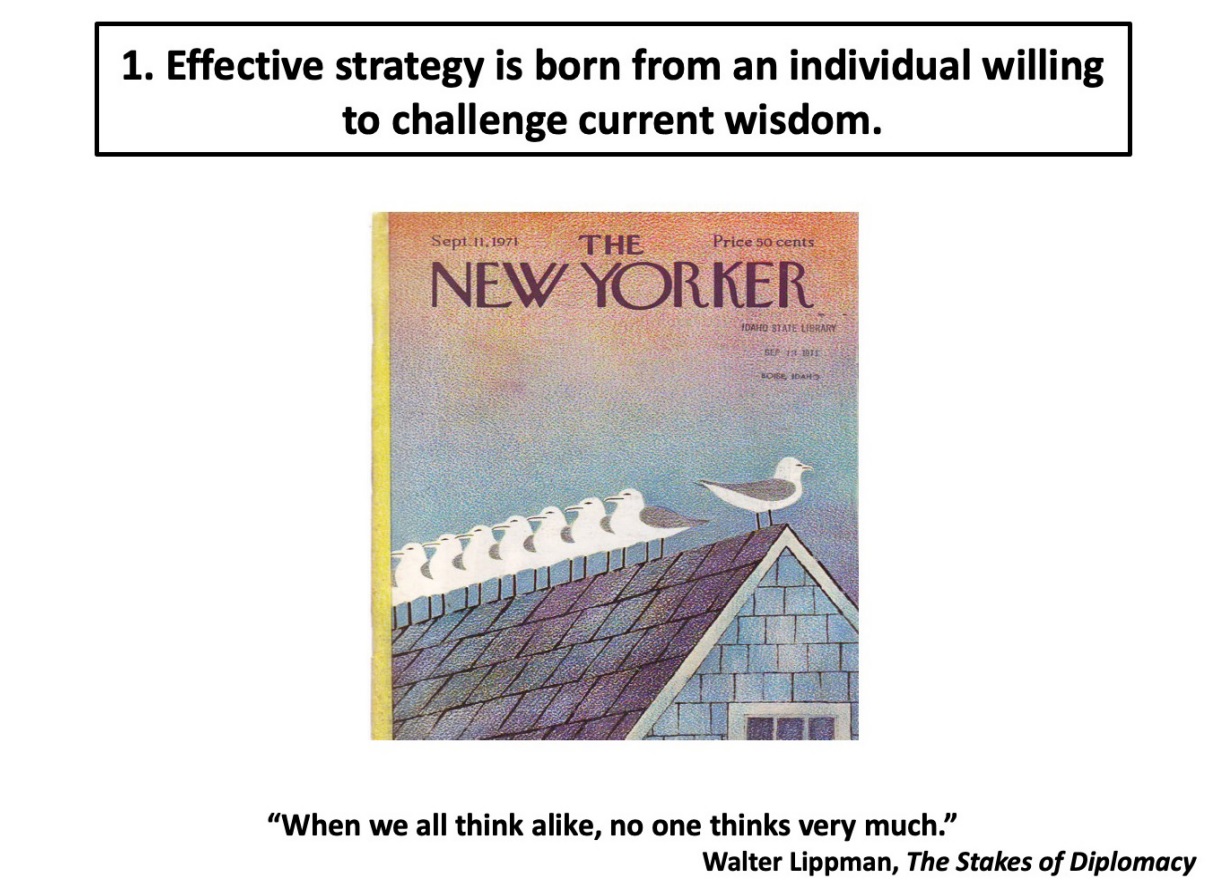
All my comments flow from personal observations, but that is appropriate. The genesis of all effective strategies occurs within the minds of individuals. The drafting of a strategy may involve a team of researchers, thinkers, and writers, but the truly innovative ideas come out of group discussions only rarely. The group may develop, reinforce, and strengthen those ideas further through conversation and debate; however, the principal or fundamental idea guiding any strategic concept inevitably is the product of the personal study, education, contemplation, and experience of an individual strategist. Thought leader is a term used frequently to describe such a person, particularly in laudatory introductions and résumés. To some it is a grandiose term, but it is appropriately descriptive.
The standard caveat applies to this publication: these are my personal observations and do not necessarily represent the official views of the Department of Defense (DoD) or the Department of the Navy. Yet that caveat also applies to the generating thought of any strategy; the final, official document, signed or released by the proper authority, represents an official view, whereas a strategy in the process of development does not. I have been by position a thought leader in the U.S. Coast Guard (USCG) and the Department of the Navy, as well as a student of strategy and history by avocation and passion. In providing these observations, I rely on over thirty years of experience in the development of strategic documents, including five years as the deputy director of strategy and policy on the staff of the Chief of Naval Operations (OPNAV) and then five more years as the director, during both stints as a member of the Senior Executive Service. Throughout this period, my position title, division designator, and relevant organizational chart have been adjusted, but the job has remained: to lead the drafting of plans and policies that direct service-wide decision-making and outline the objectives of the organization in a particular time and situation.
Time and situations change, and that is why effective strategy changes. These observations focus on the construction and production of naval strategies, not on the merits of a particular maritime or sea power strategy. During my ten years at OPNAV, I have served four Chiefs of Naval Operations (CNOs) and have had active and direct participation in the production of the following three capstone Navy service strategies (or strategic visions, as the introduction calls them):
• A Cooperative Strategy for 21st Century Seapower: Forward, Engaged, Ready (2015)—an unclassified, tri–Sea Service document
• The Navy Strategy (2018)—a classified, U.S. Navy–only strategy
• The Naval Strategy (2020)—a classified and unclassified, tri–Sea Service document
Each of these strategic visions was designed for a particular situation—a problem set, one might call it—in which the U.S. Navy needed first to determine and then to explain how it could contribute most effectively and efficiently to the national security of the United States, identifying Navy objectives and the manner in which they would be achieved. Sometimes, of course, those objectives are not achieved before the situation changes. In this monograph, I will not debate the merits of the strategic visions to which crafting naval strategy I have contributed, but will outline elements of the craft applicable to the process of determining and explaining how the U.S. Navy could contribute most effectively and efficiently to the national security of the United States.
Within OPNAV, this process includes the development of Navy input for the production of U.S. national security strategy documents, such as the National Defense Strategy and National Military Strategy, as well as the drafting of other internal Navy strategic documents such as the U.S. Navy Arctic Roadmap 2014–2030, the Navy Strategic Plan series, the Navy’s “Strategic Laydown and Dispersal Plan,” and the first USN-USCG National Fleet Plan.
Prior to this assignment, in another life, I was one of the five principal authors of the first National Strategy for Maritime Security (2005), signed by President George W. Bush, as well as the principal author of the U.S. Coast Guard’s Maritime Strategy for Homeland Security, the Coast Guard’s first National Plan to Achieve Maritime Domain Awareness, the U.S. Coast Guard Strategy for Maritime Safety, Security, and Stewardship, and the first edition of Coast Guard Publication 1, U.S. Coast Guard: America’s Maritime Guardian. The common element in all these experiences is the knowledge and skillsets that the individual participants brought to the process.
Since my goal is to pass along the accumulated knowledge and experience in the crafting of strategy to those who will perform this task in the future, it is appropriate to acknowledge the importance and intellectual independence of the individual strategist.
Observation 2
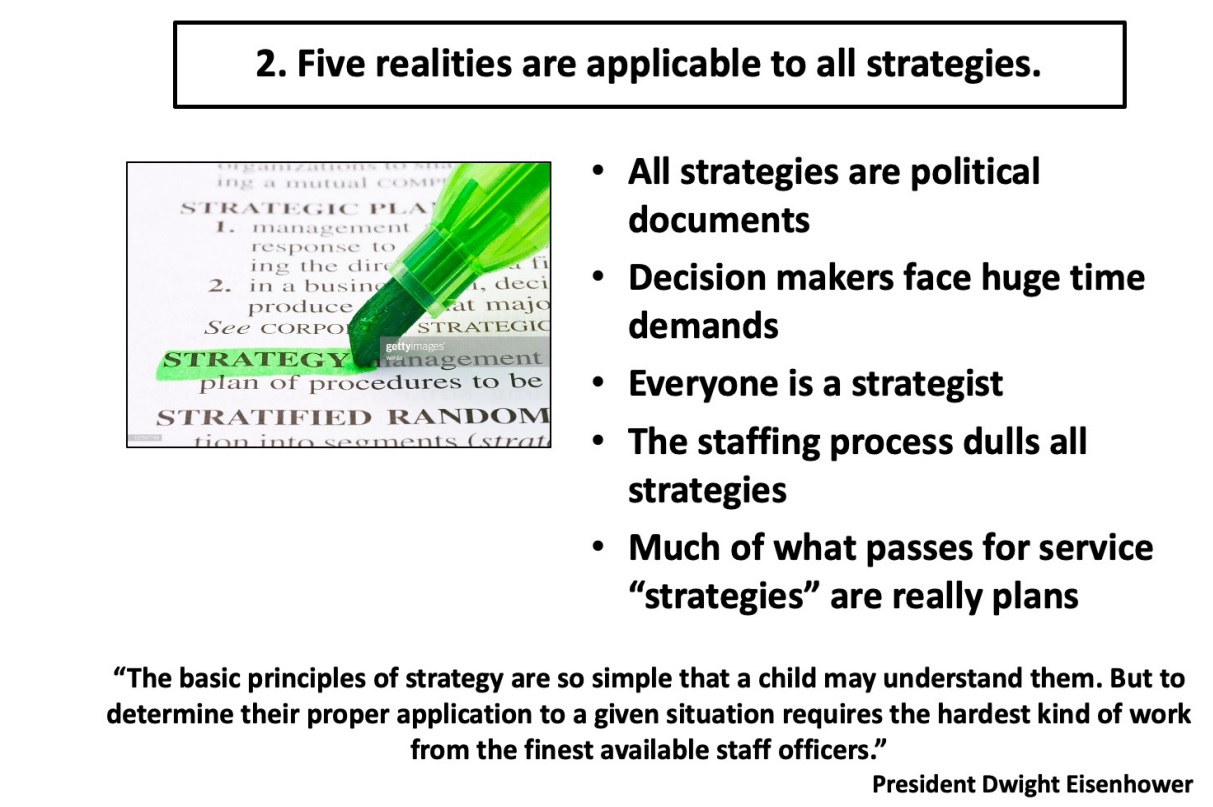
What follows are the realities that need to be kept in mind always:
All strategy statements are political documents. Whatever their form, all strategy statements are political documents that reflect accommodations, compromises, agendas both overt and hidden, and prejudices. As the introduction refers to them, these factors are the expedients. Kori N. Schake, a scholar and former government official, writes that “[s]trategy divorced from politics leads either to irrelevance, because the strategy will not be employed, or disaster, when political leaders are confronted with the unexpected costs and consequences.”1
Decision makers are subject to huge time demands. Senior leaders are caught up in pressing matters of the day and have limited time to reflect on weighty, long-term issues. This results in what might be called the difference between strategic thinking and strategy
thinking. Many senior leaders engage in strategy thinking, in that they contemplate plans to solve the pressing matters, which may range from putting together a service’s budget for the coming fiscal year to determining how to counter current gray-zone activity. Few have the time or inclination to engage in the type of long-range, service defining, “every assumption on the table” strategic thinking that is necessary for the craft of drafting a (reasonably) enduring strategic vision.
Everyone is a strategist. Col. Jobie S. Turner, USAF, expounds on this theme, noting the reality that “[i]n the Pentagon everyone fancies themselves a strategist. Every graduate of professional military education, every contractor with a new weapon system, every think-tank or consultancy pundit: all feel that if they were only given the chance, they could impose order with the right ‘big idea.’ Meanwhile, . . . ‘the programmers’ smile, content in their view that the budgets they build are the real strategy.”2
The staffing process dulls all strategies. This reality is in keeping with observation 1. Although innovative ideas start with the individual strategist, the addition of others during the staffing process necessarily affects those ideas. At best, the staffing process knocks off the rough edges and protects the interests of the decision makers from dangerous currents, ensuring that the strategy is more in keeping with their objectives; at worst, the tumbling and polishing of the ideas wear them down to almost nothing. As much as the individual strategic thinker might bewail the staffing process, this is the reality for many such projects.
Many of what pass for service strategies are really plans. Owing to the Goldwater-Nichols Act defense reforms (1986), the Naval Services no longer produce strategies such as the famous Maritime Strategy of the 1980s, which drove war and operations planning.3 Here I must confess that I disagree with the author of the introduction, who believes that such production is still possible. Yes, the services still must articulate how they intend to fight their service, but that articulation is more for force-development purposes than for actual crafting naval strategy force-employment purposes. Consequently, what passes today for Naval Service strategies are more in keeping with strategic plans or strategic concepts than pure military strategies that define the required military conditions for achieving national objectives.
Observation 3
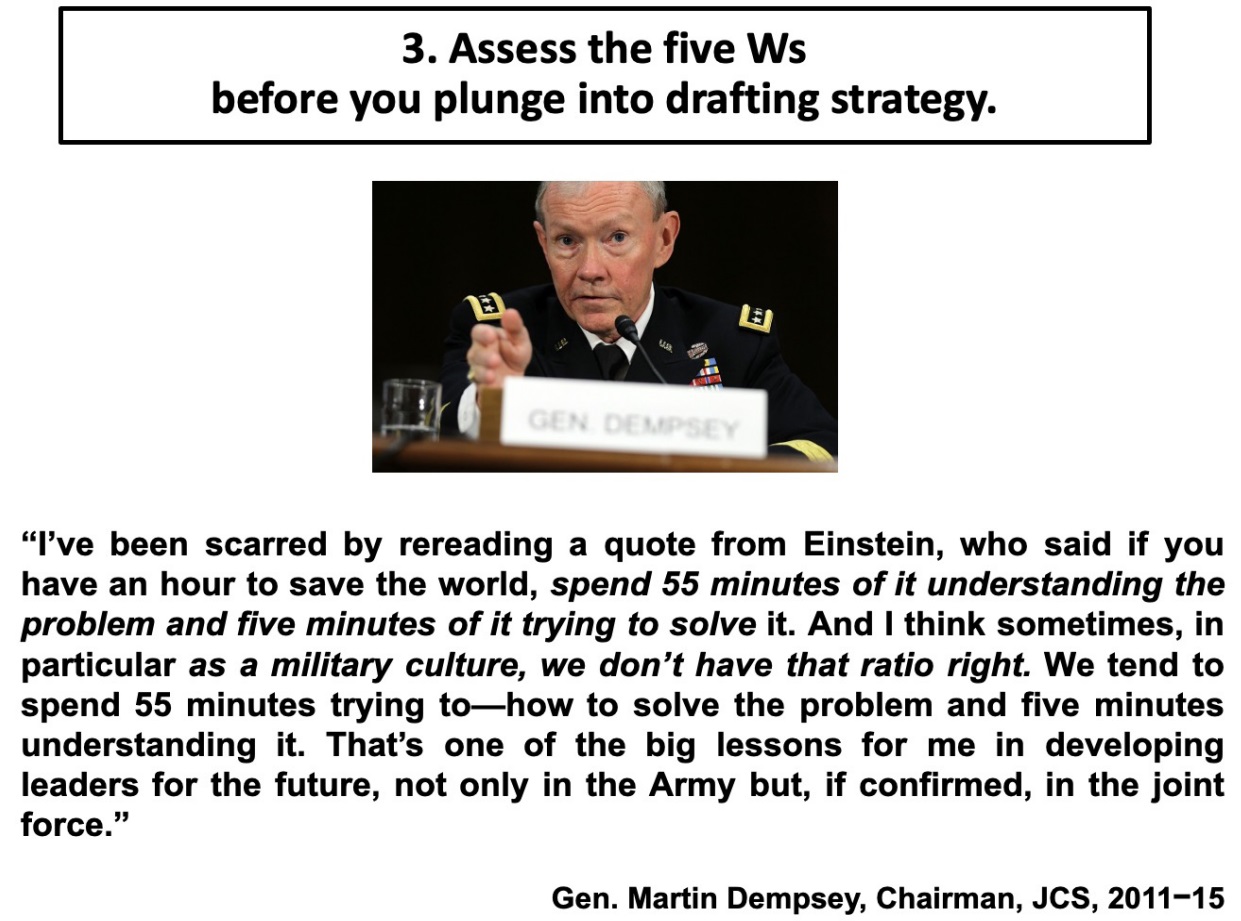
Before you immediately plunge into drafting a strategy, you need to spend your time answering the five basic W questions of journalism: who, what, where, when, and why. This will ensure a solid foundation as you go forward. “[D]efining the 5Ws first [will open]
more avenues to talk about the ideas and concepts and also [result] in more buy-in from the [staffs]. . . . It sounds simple, but Simon Sinek is right: start with why.”4 Analyzing the who, what, where, when, and why allows for identifying the problems that create the need for a strategy, the knowledge of which is the starting point for framing the strategy’s objectives and determining the best way to craft it.
Former Chairman of the Joint Chiefs of Staff (CJCS) Gen. Martin E. Dempsey, USA (2011–15), drove home this point at his 2011 confirmation hearing with his reference to a quote attributed to Einstein. “[I]f you have an hour to save the world, spend 55 minutes of it understanding the problem and five minutes of it trying to solve it. And I think sometimes, in particular as a military culture, we don’t have that ratio right. We tend to spend 55 minutes trying to [figure out] how to solve the problem and five minutes understanding it.”5
I advise all teams of crafters to start their project with an inclusive session to hammer out agreement on the five Ws. The dividend on this investment will pay out in almost every later phase of the project. It is a very effective means of building an initial framework.
Observation 5
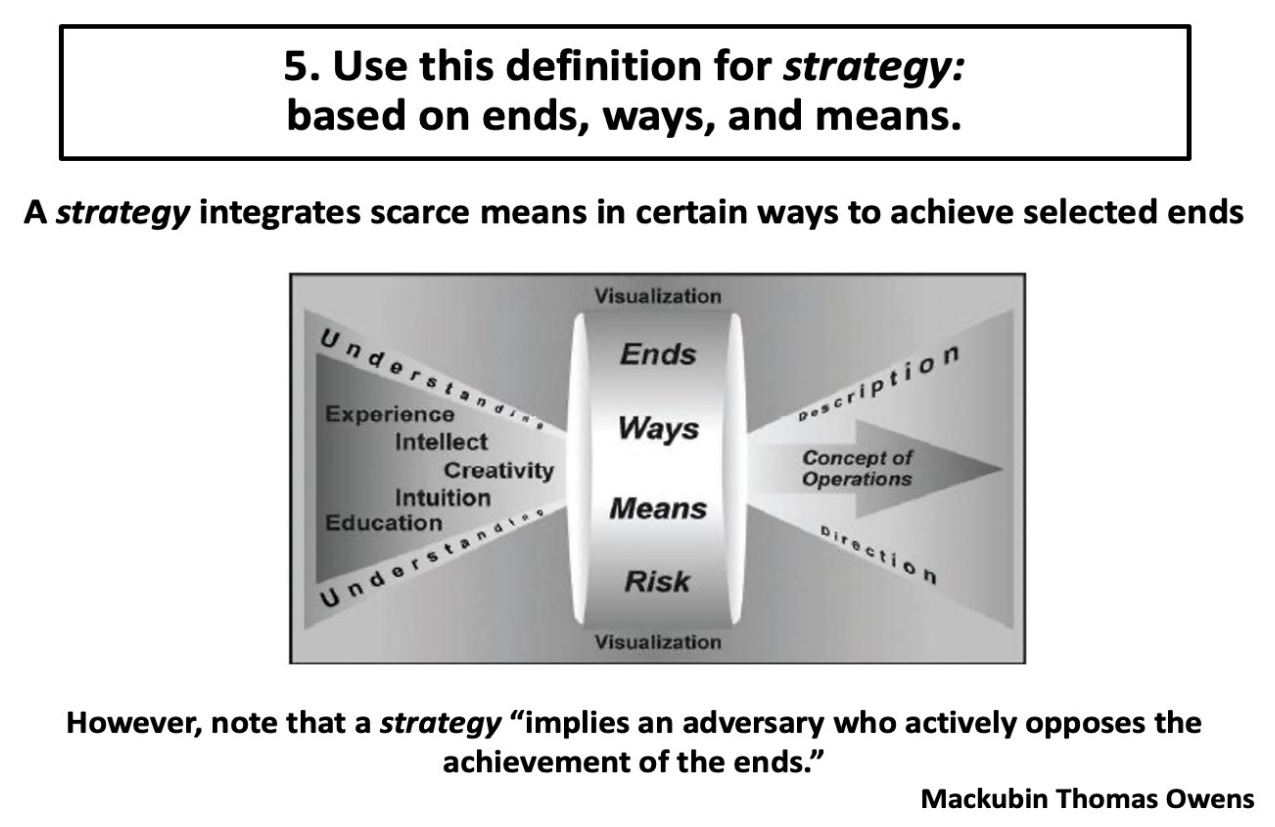
It has been my personal experience that the best approach in starting to draft any strategy is to use the ends-ways-means formula (others alter the order to ways-means-ends to reflect a bottom-up approach). For the purposes of developing naval strategy, it is “ultimately best understood as the interaction of three things, all within the context of risk assessment.”8 These are as follows:
• Ends—the goals or objectives that the strategic actor seeks to achieve
• Ways—the strategic actor’s plan of action for using the means available
• Means—the resources available to the strategic actor
Constructing a strategy with ends, ways, and means provides a clear, easy-to-follow train of logic.
The risk-assessment context includes an honest assessment of the assumptions the strategists are using to initiate the ends-ways-means construct. As Colin S. Gray advises, “To this fundamental triptych of ends, ways and means, it is advisable to insist upon adding the vital ingredient of ASSUMPTIONS. This fourth element is always important and typically reigns unchallenged as the greatest source of mischief for entire strategic enterprises.”9
The ends-ways-means formulation has become the semiofficial approach of DoD, reflected in joint documents and echoed in professional and policy journals. It is logical; it is easy to understand; it is not dependent on the elegance of the narrative; and it makes decision makers feel they are in charge of the effort (since, presumably, they have set the ends). “[A]ny strategy worth the name should articulate a clear set of achievable goals; identify concrete threats to those goals; and then, given available resources, recommend the employment of specific instruments to meet and overcome those threats.”10 As then-CJCS Adm. Michael G. Mullen, USN (2007–11), wrote in the foreword of the public National Military Strategy of the United States 2011, “The purpose of this document is to provide the ways and means by which our military will advance our enduring national interests as articulated in the 2010 National Security Strategy and to accomplish the defense objectives [ends] in the 2010 Quadrennial Defense Review.”11
Some critics question the ends-ways-means formula because the development of the means—in this case, defense acquisition—appears disconnected from the identification of the ends. A dismissive saying in DoD is that “amateurs discuss strategy; professionals discuss resources.” Arguably, defense acquisition programs do tend to take on lives of their own, seemingly regardless of changes in strategy. However, the largest defense programs take up to a decade to produce a system, making it logical that they survive incremental changes in strategy. Despite changes in presidential administrations and Congresses, American objectives do not swing wildly enough that most of these programs become irrelevant during their period of initial development.
Other critics charge that changes in technology drive strategy, not the other way around. Indeed, emerging technology would seem to be another factor that would influence the crafting of strategy, along with changes in the nature of the threat and the overall security environment (which would include diffusion of emerging technologies). Technology is thereby a driver in the same sense that all other geopolitical or geoeconomic factors are drivers.
Another criticism centers on the observation that “the United States goes to war with the forces it has, not the forces it would like.” The implication is that changes in a strategy rarely leave decision makers time to tailor the forces for its execution. However, that assumes that strategic visions last only for the short term; this mistakes the words crafting naval strategy of (new) strategy documents for the strategies themselves. The United States produced many strategic documents during the Cold War period, but the overall strategy rarely swerved.
My view is that these criticisms do not invalidate ends-ways-means as an initial approach. The strategy must connect available means to desired outcomes in creative ways, and reduce the sought-after outcomes if ways cannot be found. A good strategy avoids mismatches among the ends, ways, and means. For instance, if the means required to implement a strategy cannot be funded, then strategy must be revised by changing the ends or the ways to reduce the risk by managing the mismatches and ensuring alignment. As Colin Gray notes: “Even though strategists and those they sought to advise have been capable of adopting almost awesomely improbable assumptions, the game has always had to be about ends, ways, and means.”12
Observation 6
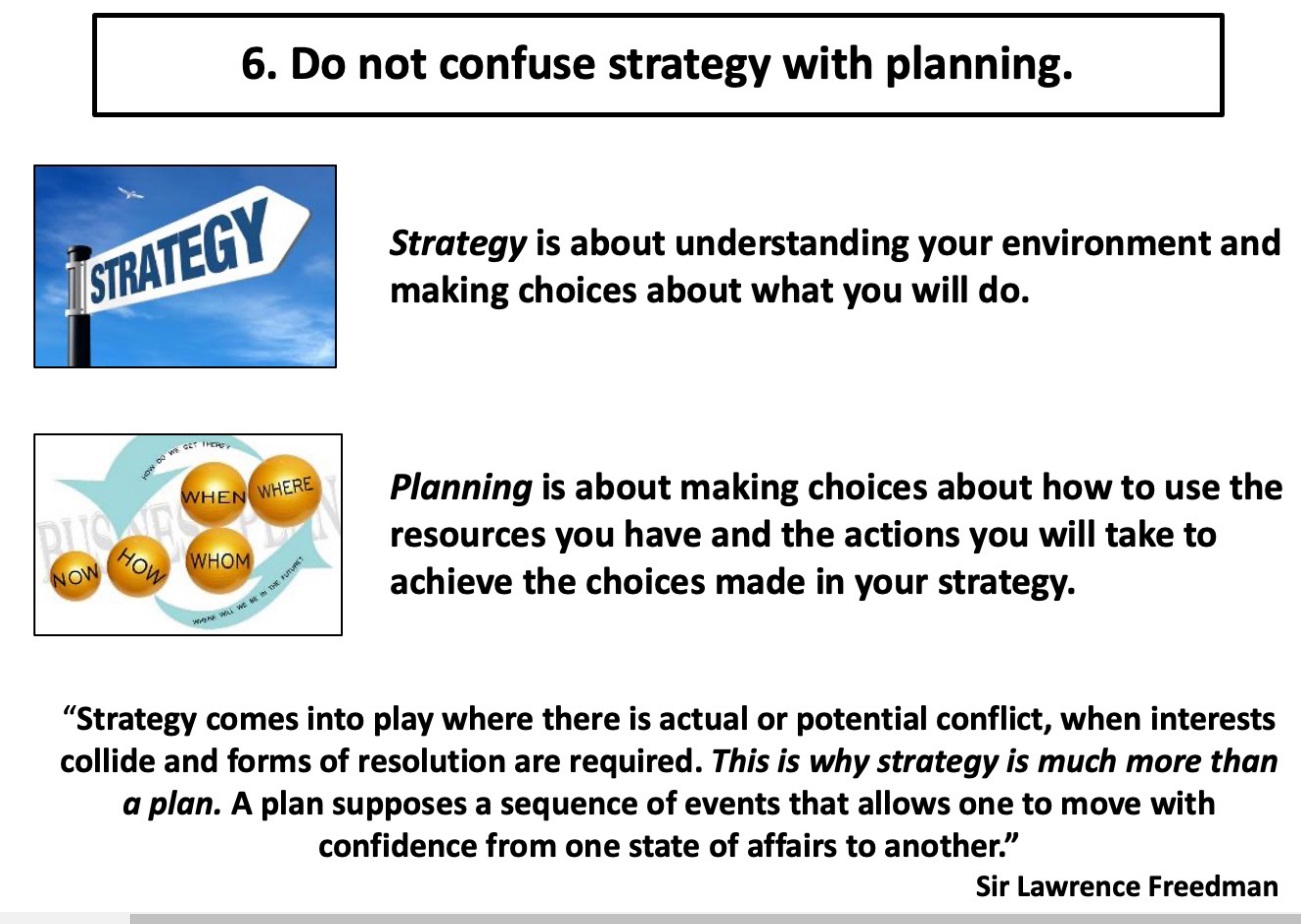
We tend to conflate strategy and planning. The essence of strategy is about making choices and setting priorities, such as the famous Allied strategy of “Germany first” in the Second World War. Strategy is what you want to do; your plan is how you actually will do it.13 As U.S. Army War College professor Harry R. Yarger notes,
“[t]he purpose of planning is to create certainty so that people and organizations can act. The purpose of strategy formulation is to clarify, influence, manage, or resolve the [volatility, uncertainty, complexity, and ambiguity] of the strategic environment through the identification and creation of strategic effects in support of policy goals. Strategy lays down what is important and to be achieved, sets the parameters for the necessary actions, and prescribes what the state is willing to allocate in terms of resources. Thus, strategy, through its hierarchal nature, identifies the objectives to be achieved and defines the box in which detailed planning can be accomplished—it bounds planning.”14
Columbia Business School professor William G. Pietersen cautions, “To be clear, planning is also important. But it is not a substitute for strategy. We don’t create a strategy with a plan. We execute it with a plan. For example, your budget should be the financial expression of your strategy, not the reverse. The right sequence is essential: strategy first, planning afterwards.”15 As noted in observation 5, however, there are those involved in DoD resource planning who might dispute that “your budget should be the financial expression of your strategy, not the reverse.” They would be wrong, of course.
This is why I raise what might seem to others merely an “issue of semantics.” There will be those outside the strategy-crafting process who will want to ensure that their “plan” (such as an acquisition proposal to solve a particular warfighting problem) is incorporated into the strategy. A firm insistence on the difference between strategies and plans might help mitigate such assaults.
Observation 7
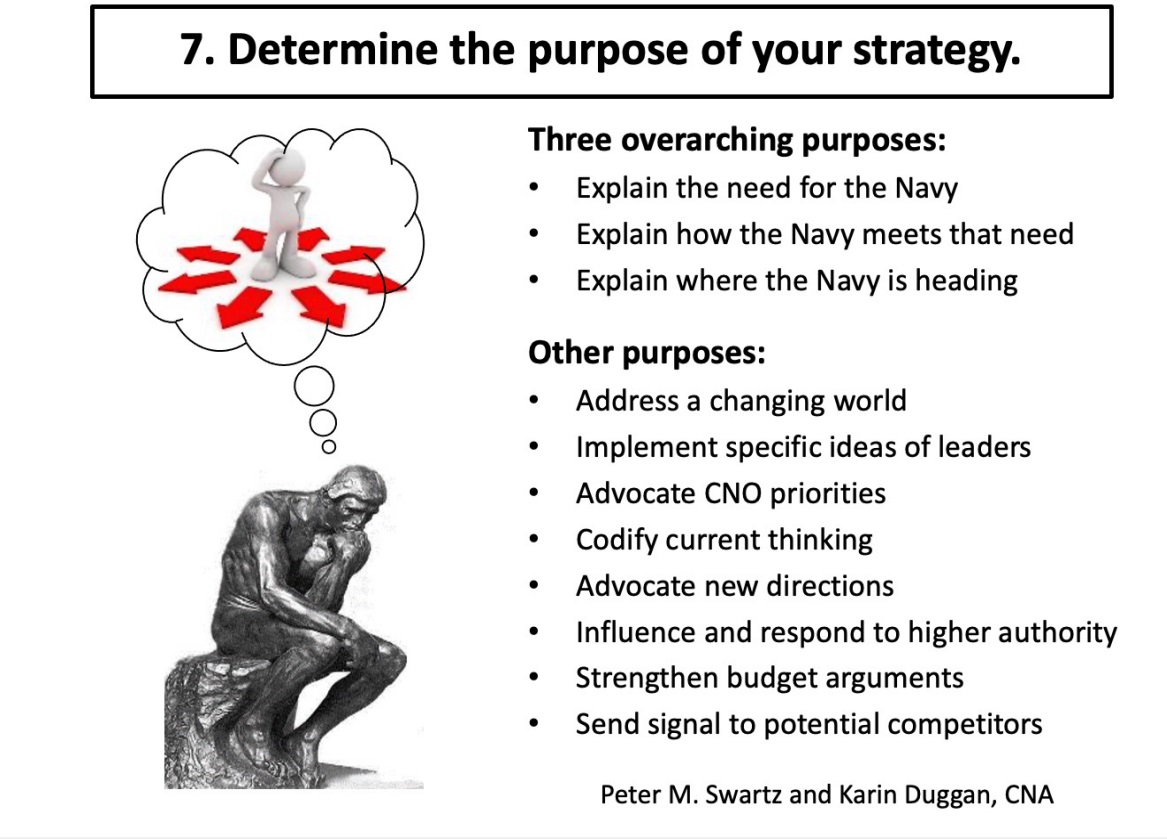
In their analysis of past Navy strategies, Capt. Peter M. Swartz, USN (Ret.), and Karin Duggan of CNA maintain that “there are a range of reasons why strategies are written.” (Some of them are listed on the slide above.) Historically, we have written Navy strategies for the three overarching purposes: to explain the need for the Navy, how the Navy meets that need, and where the Navy is heading.16 The “other purposes” actually are subsets of the big three; however, they can be examined individually to ascertain the quality of a draft strategy. In fact, they collectively constitute an informal checklist that crafters should use to analyze potential support for the draft strategy.
There is nothing nefarious about any of the individual other purposes. A naval strategy (like all military strategies) must conform in its basics to the guidance of civilian authorities, as exemplified by the National Security Strategy (NSS). As I argue later, the CNO is the Navy’s chief strategist, so advocating for his (or, eventually, her) ideas and priorities clearly is part of the process leading to implantation of the strategy. This requires the ideas to be translated into budget decisions.
Notably, one of the other purposes—signaling to potential competitors—has not been prominent in recent years, yet it was one of the more significant purposes of the public version of the Maritime Strategy of the 1980s. Arguably, the very existence of that particular strategy played a role in deterring the Soviet Union.
Observation 9
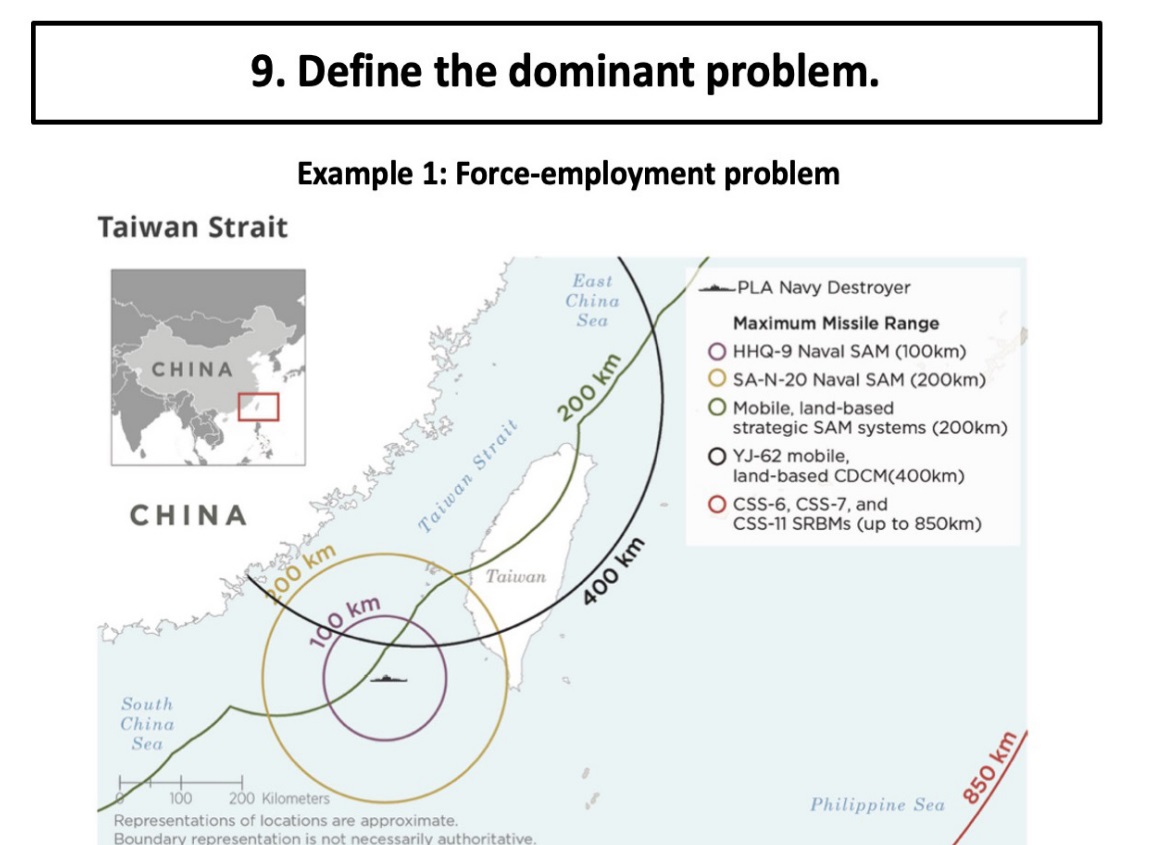
The paramount importance of understanding the dominant strategic problem is underscored by the following statement by Carl von Clausewitz: “The first, the supreme, the most far-reaching act of judgment that the statesman and commander have to make is
to establish by that test [i.e., the fit with policy goals] the kind of war on which they are embarking, neither mistaking it for, nor trying to turn it into, something that is alien to its nature.”17
Professor Turner of the U.S. Air War College offers some very useful insights on the value of a problem-based approach to strategy.
• A key to developing a strategy is to focus on the dominant military problem.
• “A problem-based approach to strategy offers several advantages.” A properly defined military problem forces the Navy to decide what is important in the future warfighting environment. “In the absence of a clear problem to solve, the future environment can become unwieldy.”
• First, a “well-thought-out military problem constrains . . . intellectual wandering,” keeping the Navy focused on what is important. “With a clear problem, it’s easier to decide how the [Navy] orients itself.” In short, the military problem keeps the Navy “grounded in reality, preventing bureaucratic inertia from overwhelming [it].”
• “Second, while aspirations are important, they must be backed by more[-]concrete, specific objectives” and coherent solutions “to win public and congressional support in the form of budgets.”
• “Third, military problems force technological solutions into a supporting role. . . . [A]s Colin Gray notes . . . , ‘Weaponry does not equal strategy.’ . . . When the problem comes first, however, the technology can come second.”
• “Fourth, solving military problems harnesses the talent already on staff and their recent operational experience. . . . With a clearly defined problem the inputs from recent warfighting are much easier to capture or, when necessary, discard.”18
Two related but distinct problems on which strategies may focus are (1) force employment (such as in war plans) and (2) force development (such as resource decisions, training, and acquisition).
The slides above and below (examples 1 and 2) illustrate force-employment problems. If China decides to use force against Taiwan or Russia assaults its Baltic neighbors, American forces likely would find themselves attempting to defend exposed territories on the adversary’s doorstep. The United States would have to project decisive power over thousands of miles, into areas where China and Russia can bring to bear capabilities more rapidly. Joint forces must be ready to fight large-scale combat operations in a joint, multinational, multidomain environment, under the most demanding conditions. Maritime formations must be capable of fighting through layers of enemy anti-access systems while operating in a degraded communications environment and under constant surveillance.
Obviously, force-deployment strategies must be based on the capabilities and employment of joint forces, even if they describe only the naval component. Ultimately such strategies require integration with joint planning and must be designed with that in mind. Additionally, they must be compatible with the projected contributions of allies and partners.
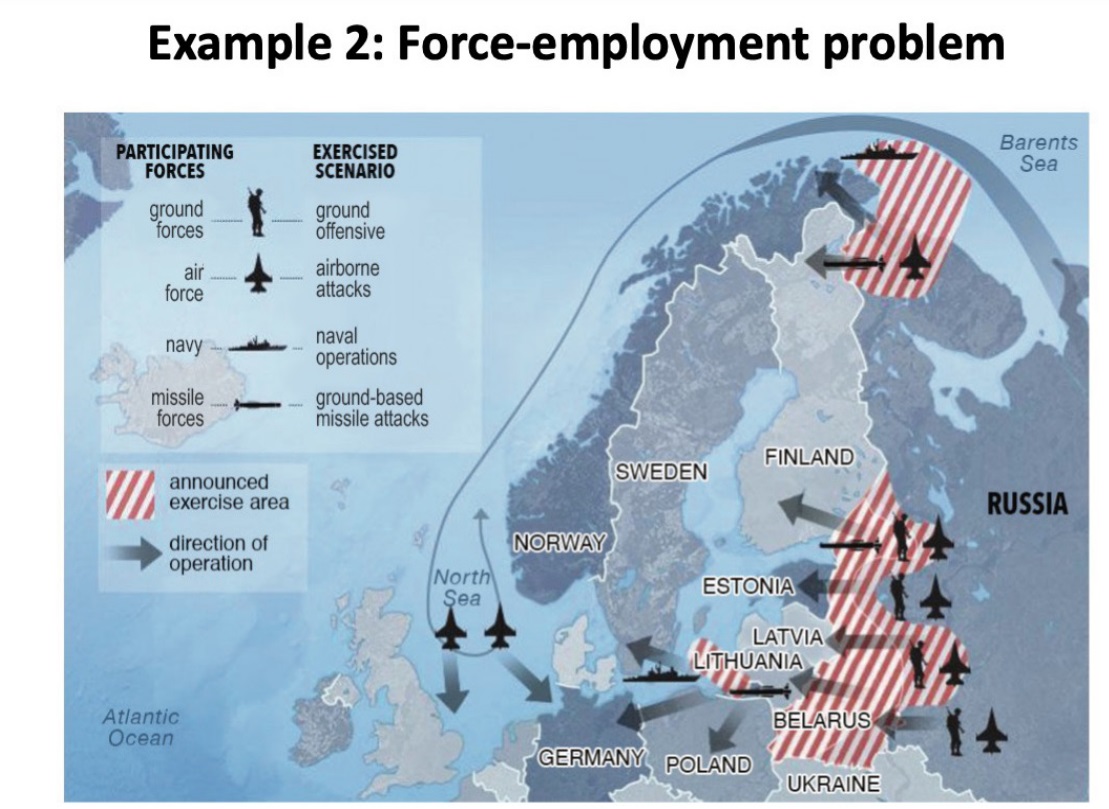
Although the ultimate goal of service strategies is the solution of real-world strategic force-employment problems, they necessarily focus on force-development problems—that is, how to man, train, equip, and prepare the forces necessary for the potential employment. As noted before, the services are creating the means by which force employment problems can be solved—which actually requires a more complex, intricate, nuanced, persuasive, and politically savvy strategy than the employment problem, which assumes that the forces already exist and the decision to carry out
the action already has been made. Crafting a force-development strategy calls for the greatest level of creativity.
Bruce B. Stubbs, SES, is Director of Navy Strategy, Office of the Chief of Naval Operations (OPNAV N7).
Featured Image: ATLANTIC OCEAN (March 26, 2022) The aircraft carrier USS Gerald R. Ford (CVN 78) transits the Atlantic Ocean, March 26, 2022.(U.S. Navy photo by Mass Communication Specialist 3rd Class Jackson Adkins)

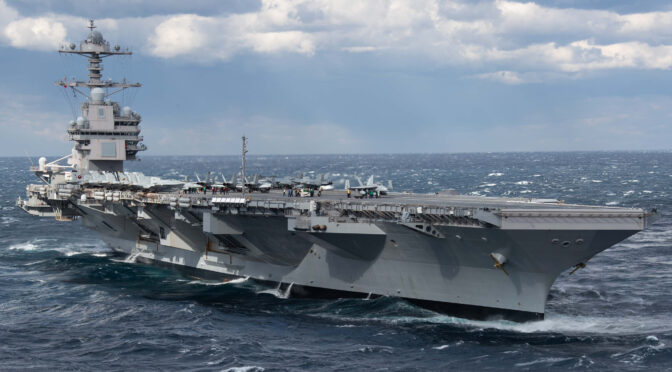
Excellent paper to understand the area to be considered when developing a naval strategy. This study would definitely help me to proceed with my PhD studies on maritime Diplomacy and Small State Security. Thank you for sharing your knowledge.